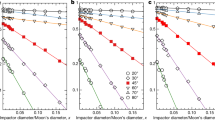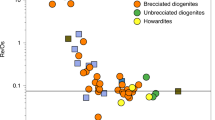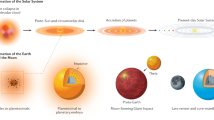Abstract
After the Moon’s formation, Earth experienced a protracted bombardment by leftover planetesimals. The mass delivered during this stage of late accretion has been estimated to be approximately 0.5% of Earth’s present mass, based on highly siderophile element concentrations in the Earth’s mantle and the assumption that all highly siderophile elements delivered by impacts were retained in the mantle. However, late accretion may have involved mostly large (≥ 1,500 km in diameter)—and therefore differentiated—projectiles in which highly siderophile elements were sequestered primarily in metallic cores. Here we present smoothed-particle hydrodynamics impact simulations that show that substantial portions of a large planetesimal’s core may descend to the Earth’s core or escape accretion entirely. Both outcomes reduce the delivery of highly siderophile elements to the Earth’s mantle and imply a late accretion mass that may be two to five times greater than previously thought. Further, we demonstrate that projectile material can be concentrated within localized domains of Earth’s mantle, producing both positive and negative 182W isotopic anomalies of the order of 10 to 100 ppm. In this scenario, some isotopic anomalies observed in terrestrial rocks can be explained as products of collisions after Moon formation.
This is a preview of subscription content, access via your institution
Access options
Access Nature and 54 other Nature Portfolio journals
Get Nature+, our best-value online-access subscription
$29.99 / 30 days
cancel any time
Subscribe to this journal
Receive 12 print issues and online access
$259.00 per year
only $21.58 per issue
Buy this article
- Purchase on Springer Link
- Instant access to full article PDF
Prices may be subject to local taxes which are calculated during checkout




Similar content being viewed by others
References
Raymond, S. N., Schlichting, H. E., Hersant, F. & Selsis, F. Dynamical and collisional constraints on a stochastic late veneer on the terrestrial planets. Icarus 226, 671–681 (2013).
Canup, R. M. Simulations of a late lunar-forming impact. Icarus 168, 433–456 (2004).
Mann, U., Frost, D. J., Rubie, D. C., Becker, H. & Audétat, A. Partitioning of Ru, Rh, Pd, Re, Ir and Pt between liquid metal and silicate at high pressures and high temperatures — implications for the origin of highly siderophile element concentrations in the Earth’s mantle. Geochim. Cosmochim. Acta 84, 593–613 (2012).
Rubie, D. C. et al. Accretion and differentiation of the terrestrial planets with implications for the compositions of early-formed Solar System bodies and accretion of water. Icarus 248, 89–108 (2015).
Kimura, K., Lewis, R. S. & Anders, E. Distribution of gold and rhenium between nickel-iron and silicate melts: implications for the abundance of siderophile elements on the Earth and Moon. Geochim. Cosmochim. Acta 38, 683–701 (1974).
Chou, C.-L. Fractionation of siderophile elements in the Earth’s upper mantle. In Proc. 9th Lunar and Planetary Science Conference 219–230 (1978).
Walker, R. J. Highly siderophile elements in the Earth, Moon and Mars: update and implications for planetary accretion and differentiation. Chem. Erde 69, 101–125 (2009).
Rubie, D. C., Melosh, H. J., Reid, J. E., Liebske, C. & Righter, K. Mechanisms of metal-silicate equilibration in the terrestrial magma ocean. Earth Planet. Sci. Lett. 205, 239–255 (2015).
Kendall, J. D. & Melosh, H. J. Differentiated planetesimal impacts into a terrestrial magma ocean: fate of the iron core. Earth Planet. Sci. Lett. 448, 24–33 (2016).
Bottke, W. F., Walker, R. J., Day, J. M. D., Nesvorny, D. & Elkins-Tanton, L. Stochastic late accretion to Earth, the Moon, and Mars. Science 330, 1527–1530 (2010).
Marchi, S. et al. Widespread mixing and burial of Earth’s Hadean crust by asteroid impacts. Nature 511, 578–582 (2014).
Pahlevan, K. & Morbidelli, A. Collisionless encounters and the origin of the lunar inclination. Nature 527, 492–494 (2015).
Dahl, T. W. & Stevenson, D. J. Turbulent mixing of metal and silicate during planet accretion — and interpretation of the Hf–W chronometer. Earth Planet. Sci. Lett. 295, 177–186 (2010).
Deguen, R., Landeau, M. & Olson, P. Turbulent metal-silicate mixing, fragmentation, and equilibration in magma oceans. Earth Planet. Sci. Lett. 391, 274–287 (2014).
Wade, J. & Wood, B. J. Core formation and the oxidation state of the Earth. Earth Planet. Sci. Lett. 236, 78–95 (2005).
Kraus, R. G. et al. Impact vaporization of planetesimal cores in the late stages of planet formation. Nat. Geosci. 8, 269–272 (2015).
Kleine, T. et al. Hf–W chronology of the accretion and early evolution of asteroids and terrestrial planets. Geochim. Cosmochim. Acta 73, 5150–5188 (2009).
Willbold, M., Elliott, T. & Moorbath, S. The tungsten isotopic composition of the Earth’s mantle before the terminal bombardment. Nature 477, 195–198 (2011).
Touboul, M., Puchtel, I. S. & Walker, R. J. 182W evidence for long-term preservation of early mantle differentiation products. Science 335, 1065–1069 (2012).
Puchtel, I.S., Blichert-Toft, J., Touboul, M., Horan, M. F. & Walker, R. J. Coupled 182W–142Nd record of the early differentiation of Earth’s mantle. Geochem. Geophys. Geosyst. 17, GC006324 (2016).
Rizo, H. et al. Memories of Earth formation in the modern mantle: W isotopic compositions of flood basalt lavas. Science 352, 809–812 (2016).
Willbold, M., Mojzsis, S. J., Chen, H.-W. & Elliott, T. Tungsten isotope composition of the Acasta Gneiss Complex. Earth Planet. Sci. Lett. 419, 168–177 (2015).
Ćuk, M. & Stewart, S. T. Making the Moon from a Fast-Spinning Earth: A Giant Impact Followed by Resonant Despinning. Science 338, 1047–1052 (2012).
Canup, R. M. Forming a Moon with an Earth-like composition via a giant impact. Science 338, 1052–1055 (2012).
Nakajima, M. & Stevenson, D. J. Melting and mixing states of the Earth’s mantle after the Moon-forming impact. Earth Planet. Sci. Lett. 427, 286–295 (2015).
Mundl, A. et al. Tungsten-182 heterogeneity in modern ocean island basalts. Science 356, 66–69 (2017).
Rizo, H. et al. Early Earth differentiation investigated through 142Nd, 182W, and highly siderophile element abundances in samples from Isua, Greenland. Geochim. Cosmochim. Acta 175, 319–336 (2016).
Dale, C. W., Kruijer, T. S. & Burton, K. W. Highly siderophile element and 182W evidence for a partial late veneer in the source of 3.8 Ga rocks from Isua, Greenland. Earth Planet. Sci. Lett. 458, 394–404 (2017).
O’Brien, D. P., Morbidelli, A. & Levison, H. F. Terrestrial planet formation with strong dynamical friction. Icarus 184, 39–58 (2006).
Jacobson, S. A. & Morbidelli, A. Lunar and terrestrial planet formation in the Grand Tack scenario. Phil. Trans. R. Soc. A 372, 0174 (2014).
Morbidelli, A., Marchi, S., Bottke, W. F. & Kring, D. A. A sawtooth-like timeline for the first billion years of lunar bombardment. Earth Planet. Sci. Lett. 355–356, 144–151 (2012).
Touboul, M., Puchtel, I. S. & Walker, R. J. Tungsten isotopic evidence for disproportional late accretion to the Earth and Moon. Nature 520, 530–533 (2015).
Kruijer, T. S., Kleine, T., Fischer-Gödde, M. & Sprung, P. Lunar tungsten isotopic evidence for the late veneer. Nature 520, 534–537 (2015).
Marchi, S., Bottke, W. F., Kring, D. A. & Morbidelli, A. The onset of the lunar cataclysm as recorded in its ancient crater populations. Earth Planet. Sci. Lett. 325, 27–38 (2012).
Pritchard, M. E. & Stevenson, D. J. in Origin of the Earth and Moon (eds Canup, R. M. & Righter, K.) 179 (Univ. Arizona Press, Tuscon, 2000).
Levison, H. F., Kretke, K. A., Walsh, K. J. & Bottke, W. F. Growing the terrestrial planets from the gradual accumulation of sub-meter sized objects. Proc. Natl Acad. Sci. USA 112, 14180–14185 (2015).
Barr, A. C. & Canup, R. M. Origin of the Ganymede–Callisto dichotomy by impacts during the late heavy bombardment. Nat. Geosci. 3, 164–167 (2010).
Jackson, A. P. & Wyatt, M. C. Debris from terrestrial planet formation: the Moon-forming collision. Mon. Notices Royal Astron. Soc. 425, 657–679 (2012).
Bottke, W. F. et al. Dating the Moon-forming impact event with asteroidal meteorites. Science 348, 321–323 (2015).
Melosh, H. J. A hydrocode equation of state for SiO2. Meteorit. Planet. Sci. 42, 2079–2098 (2007).
Wacheul, J.-B., Le Bars, M., Monteux, J. & Aurnou, J. M. Laboratory experiments on the breakup of liquid metal diapirs. Earth Planet. Sci. Lett. 403, 236–245 (2014).
Canup, R. M. Lunar-forming collisions with pre-impact rotation. Icarus 196, 518–538 (2008).
Elkins-Tanton, L. T. Magma oceans in the inner solar system. Annu. Rev. Earth Planet. Sci. 40, 113–139 (2012).
Zahnle, K. J., Lupu, R., Dobrovolskis, A. & Sleep, N. H. The tethered Moon. Earth Planet. Sci. Lett. 427, 74–82 (2015).
Elkins-Tanton, L. T. Linked magma ocean solidification and atmospheric growth for Earth and Mars. Earth Planet. Sci. Lett. 271, 181–191 (2008).
Hamano, K., Abe, Y. & Genda, H. Emergence of two types of terrestrial planet on solidification of magma ocean. Nature 497, 607–610 (2013).
Solomatov, V. S. in Treatise on Geophysics Vol. 9 (ed. Schubert, G.) 91–120 (Elsevier, Heinrich, 2007).
Samuel, H. A re-evaluation of metal diapir breakup and equilibration in terrestrial magma oceans. Earth Planet. Sci. Lett. 313, 105–114 (2012).
Stevenson, D. J. in Origin of the Earth (ed. Jones, H.E.N.a.J.H.) 231–250 (Oxford University Press, New York, 1990).
King, C. & Olson, P. Heat partitioning in metal-silicate plumes during Earth differentiation. Earth Planet. Sci. Lett. 304, 577–586 (2011).
Zimmerman, M. E., Zhang, S., Kohlstedt, D. L. & Karato, S.-I. Melt distribution in mantle rocks deformed in shear. Geophys. Res. Lett. 26, 1505–1508 (1999).
Acknowledgements
We thank F. Nimmo, K. Pahlevan, D. Stevenson and A. Morbidelli for discussion and comments that greatly improved the paper. S.M. and R.M.C. thank NASA Exobiology grant NNX15AL26G and NASA SSERVI programmes for support. R.J.W. acknowledges NASA Emerging Worlds grant NNX16AN07G, and NASA SSERVI grant NNA14AB07A.
Author information
Authors and Affiliations
Contributions
S.M. conceived the work and analysed SPH results. R.M.C. performed SPH simulations and analysed the results. R.J.W. contributed HSE and W data and interpretation. All authors wrote the manuscript and discussed the results.
Corresponding author
Ethics declarations
Competing interests
The authors declare no competing financial interests.
Additional information
Publisher’s note: Springer Nature remains neutral with regard to jurisdictional claims in published maps and institutional affiliations.
Electronic supplementary material
Supplementary Information
Supplementary figures and tables
Rights and permissions
About this article
Cite this article
Marchi, S., Canup, R.M. & Walker, R.J. Heterogeneous delivery of silicate and metal to the Earth by large planetesimals. Nature Geosci 11, 77–81 (2018). https://doi.org/10.1038/s41561-017-0022-3
Received:
Accepted:
Published:
Issue Date:
DOI: https://doi.org/10.1038/s41561-017-0022-3
This article is cited by
-
Long-lived volcanic resurfacing of Venus driven by early collisions
Nature Astronomy (2023)
-
The accretion of planet Earth
Nature Reviews Earth & Environment (2022)
-
The core-merging giant impact in Earth’s accretion history and its implications
Acta Geochimica (2022)
-
The essence of life revisited: how theories can shed light on it
Theory in Biosciences (2022)
-
Late veneer and the origins of volatiles of Earth
Acta Geochimica (2022)



